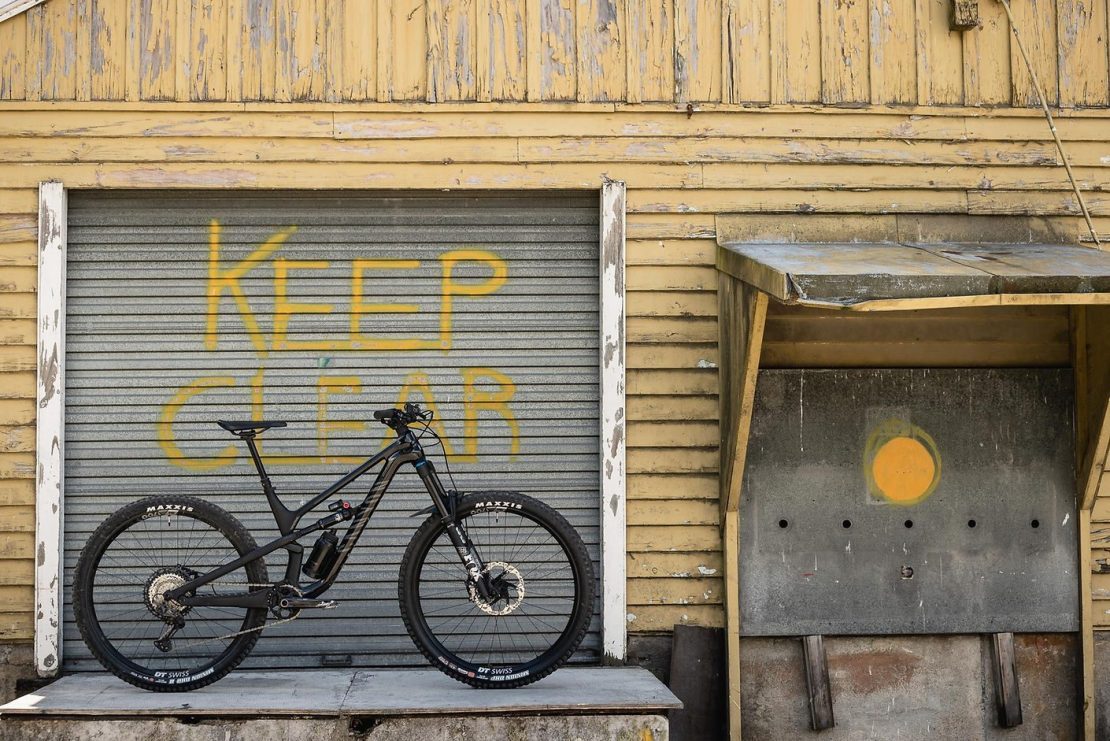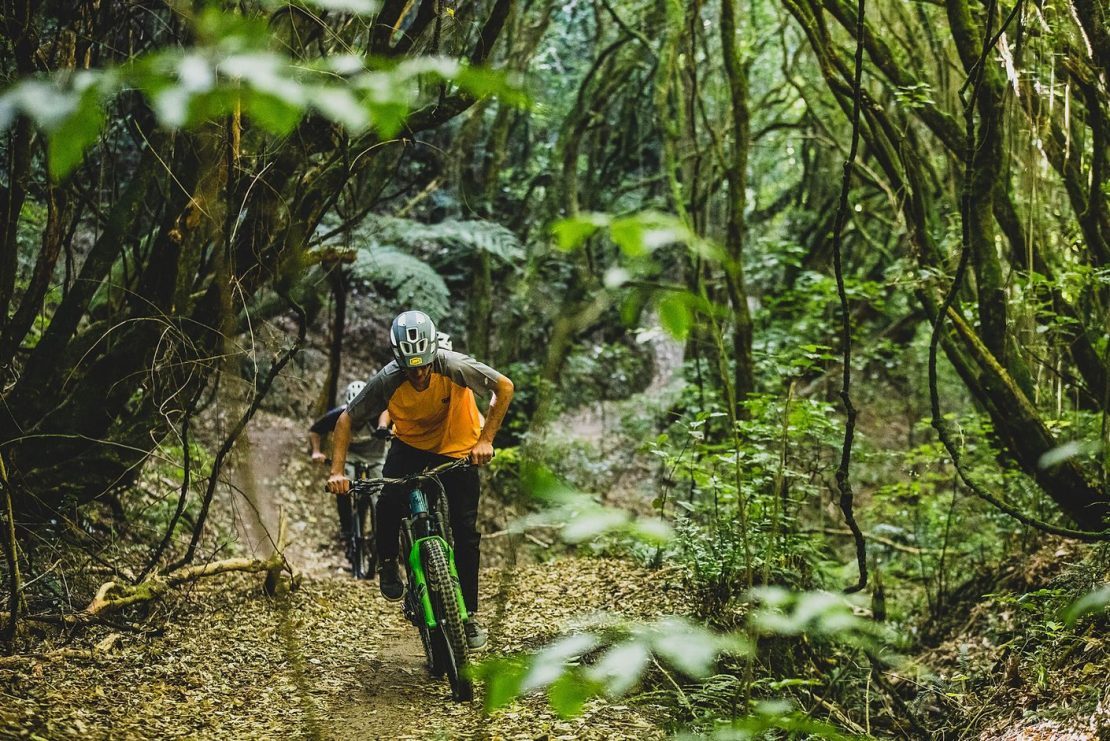Feature: From Birth to Evolution
Four Forty Mountain Bike Park enters its sixth season of operation in 2021.
Back in November 2014, backing onto the Hunua Ranges just south of Auckland, in a previously little-known part of the North Island (for most serious mountain bike trail connoisseurs), Four Forty Mountain Bike Park opened to the public for the very first time. Fast forward to October 2021 and the park is entering its seventh season of full commercial operation.
The project, originally headed by Byron Scott and Aaron Tait – before Byron bought out his business partner in 2017 – has seen many iterations. Most recently, there has been trail work completed by Trailpro and sizable investments made in park infrastructure, in preparation for this coming season. In recent years, the park has been through its most visible changes largely due to pine harvesting, as the park operations are undertaken on a fully operational forestry block.
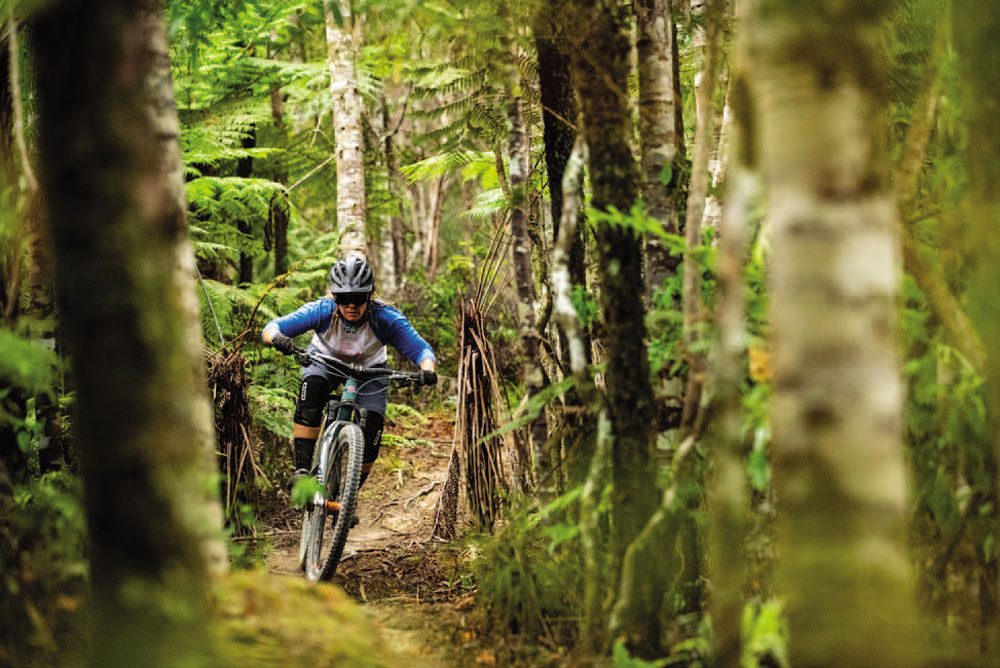
Not to worry – there is still plenty of lush native forest and pines to accommodate your party in the woods. Due to clear felling in sections of the park in the winter of 2019, several of the original trails have been fully rebuilt including Pretty Fly which, overlooking the Hauraki Gulf and the Firth of Thames, surely has the most spectacular jump lines in New Zealand.
Park developments are not limited to the trails. This season, substantial investment has been made at the base area. Previously, the park ticketing office, retail, workshop and bike rental was all run out of several well-dressed containers. What was a little too rustic to be safe for public use, the sheep shearing shed has been replaced by a much more permanent 150m2 building, including an office and retail space larger in size than most dedicated urban retail spaces. The character of the old sheep shearing HQ has been thoughtfully maintained, with a nod to the land’s previous commercial uses. This asset signals the permeance of the park and Byron’s intention to continue to improve all aspects of the customer experience. Surrounding the base building, over 4000 native plants have been placed as evidence of the thought and care that has gone into all aspects of the park’s current existence.
It has been no easy feat to reach this level of development in just six years with nothing but private investment from Byron himself, and with support from enthusiastic landowners who allow this activity to take place on a fully operational forestry block. It has been Byron’s enthusiasm for mountain biking, quality trails and seeing diehard customers return to the park to ride year after year that has fueled the efforts required to open and operate the park each season. In the early years, customers trickled though the gates and many issues with the management and operation of the shuttle vehicles put barriers in the way of consistent growth in the business. But, having spent so much time and personal money on the venture – to the point that Byron’s perseverance, coupled with a will to solve or work around issues that arose, is what eventually pushed the operation through the challenging startup years. Byron compares the journey to a crawl across the desert; “you are halfway across the desert – what do you do?”. It is this bullish approach, combined with Byron’s creative problem solving, that results in an approach to life and business for him that most would shy away from.
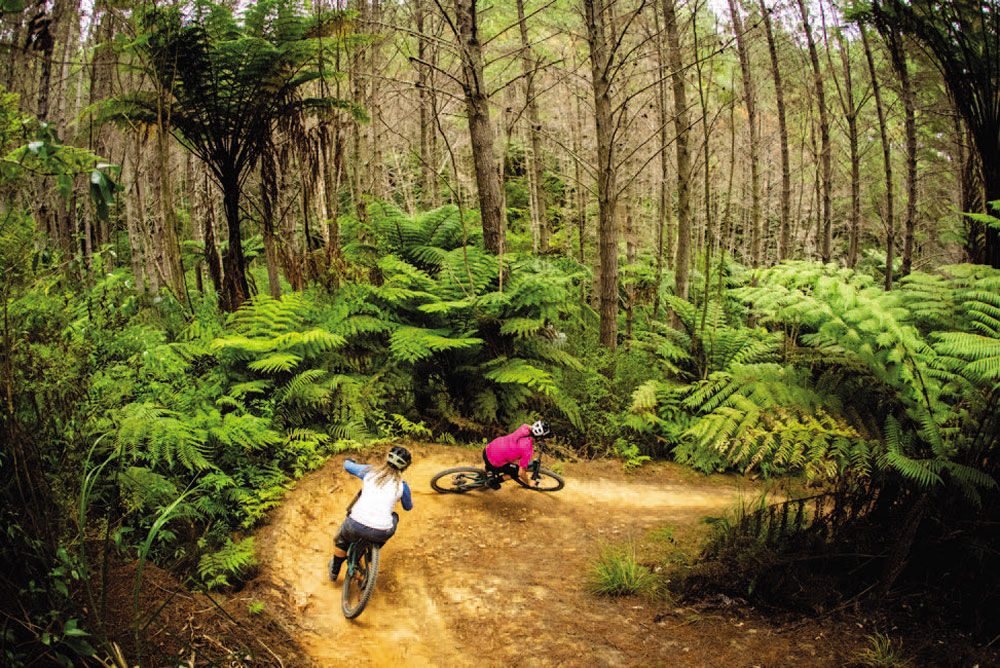
Once the formal years had been navigated, the key to the park’s growth — which has enabled the continued development towards entering this next phase for the business – has been the trail quality. When the park first went into operation, there was just six km’s of trail. Today, 22km of trail exists in the park, with a variety of trail styles and grades - the quality of which is rivaled by few commercial bike parks globally. The attention to detail in the construction of the trails – and, as a result, the ride experience for the customer – can only be described as a true feeling of flow. This is what keeps the core local and regional customers coming back and is now starting to attract users from an increasingly wider geographical area.
From narrow, off camber hand cut lines and a national downhill racetrack, to fast flowing digger- built lines and flowing jump lines, the park has evolved significantly. In the context of running a commercially sustainable bike park, it’s not just the trails alone that contribute to the overall experience of the customers; Byron believes this is the single largest contributing factor to attracting repeat business.
It’s not just the quality of the trails that bring riders from far and wide; Four Forty has been home to a swathe of national and regional events since day one, including Auckland Downhill Champs, National Cross Country and Downhill Series rounds, the annual 440 Gravity Enduro, National Secondary Schools champs and, of course, none other than the Dodzy Memorial Enduro.
The kickoff to the 2021 / 2022 season was delayed due to the recent Covid lock downs. With the park fully polished and ready for opening in September the momentum of park trail crew, and staff had to be redirected temporarily.
In true 440 spirit the situation was managed, plans were changed, and they made the best of the situation by distracting themselves and their customers by posting humorous content to their social media channels and by building their new fleet of Transition rental bikes.
The park was finally able to open for the season on the 10th of November albeit at reduced capacity to comply with current operational restrictions. Needless to say, the staff are happy to serve the customers and the customers are happy to be back riding at one of the best niche gravity riding locations New Zealand has to offer.
• Located a leisurely 50 minute drive directly east of Auckland Airport – or rather, 2 hours 45 from Redwoods – Whakarewarewa Forest, Rotorua – for the mountain bikers of New Zealand.
Words: Cam Cole
Photography: Sven Martin
Story: Lens of a Local
Spend 48hrs in Rotorua riding with a local and you’ll return home yearning for more. It’s not just the place but the people who make this iconic mountain bike town shine. To round the year out (and what a bloody weird year) Gary (Gaz) Sullivan invited us to come and ride his local trails aboard the new Canyon Spectral 29.
The early summer weather was in full swing and long days meant for long rides. To start the 48hrs we’d heard about the amazing sunsrise at the bench overlooking Mount Tarawera. It’s best to start with a bang so we rose early to be up there before the sun. Before the sun – the pre-dawn when you feel most connected to Papatūānuku. The faint light before dawn was soon overshadowed by the sun’s rays peeking over Mount Tarawera. Once the sun was up, part two of our adventure began.
Canyon Spectral 29 Tech
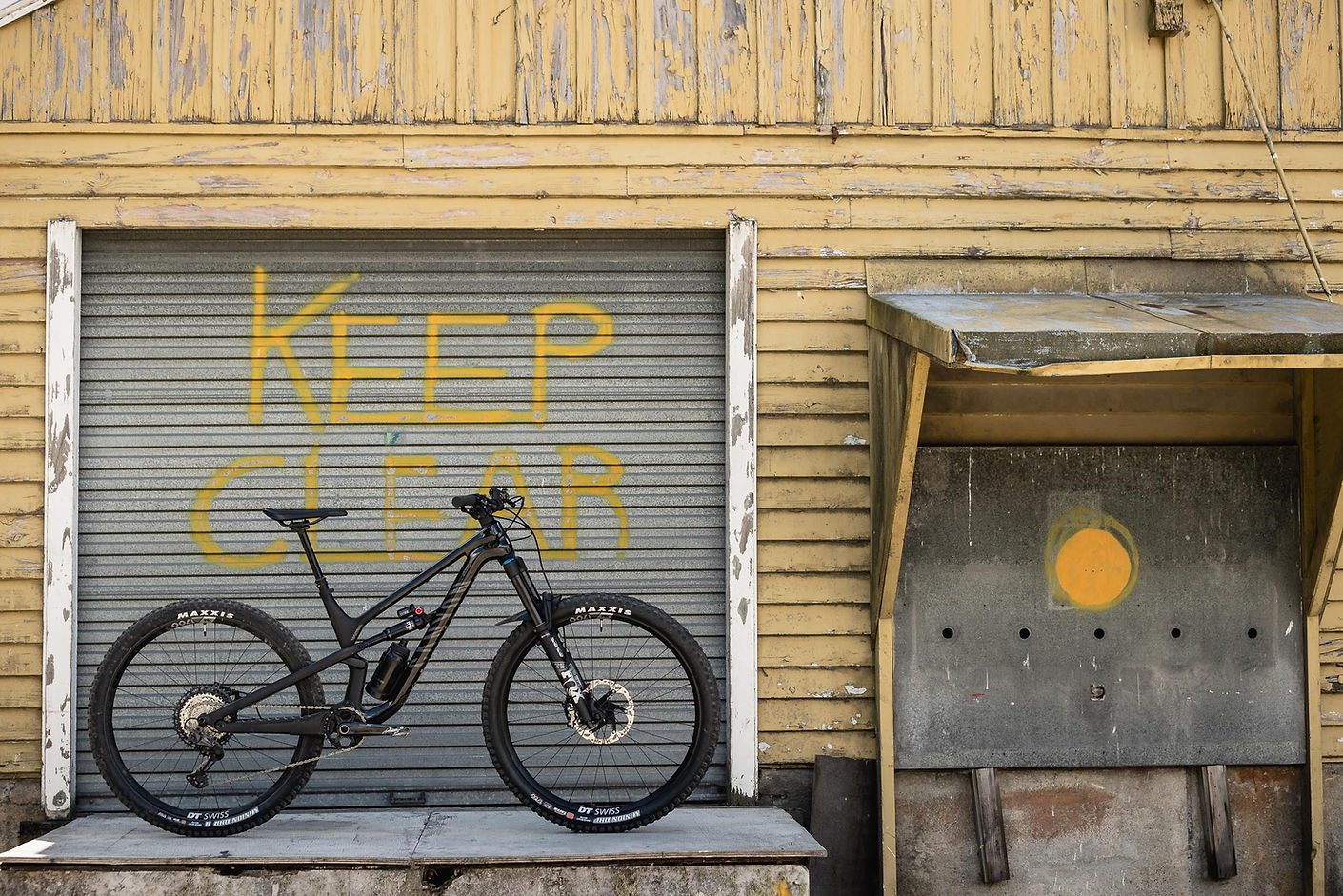
Firstly, as Canyon is a consumer-direct brand it’s worth noting that the box arriving is the first thing you actually touch and feel from the brand. They ensure it’s a good experience the box that the bike comes in is super organised and uses minimal excess bubble wrap and plastic.
The Canyon Spectral CF 29 is a new trail bike from the direct-to-consumer company. The rig comes with 150 mm travel at the rear and, depending on the model, 150mm or 160mm upfront. So, you might have guessed by the name, but yea, it rolls 29 wheels. Initially only available as a carbon version (CF). Canyon’s masterplan with the Spectral 29 was to mix the agility of the 27.5” existing model with additional stability. The Spectral 29 bears little resemblance to its 27.5” counterpart. This is ground up and the geometry and suspension have had fundamental revisions. And even though there’s longer geometry the company claim it’s lighter than the Spectral 27.5”. But it’s stiffer too thanks to the huge chainstays (with tough protector) and reduced kink in the downtube. However, with the thick chainstays, it does limit the Spectral 29 to 30-34 chainrings. Canyon’s own G5 cockpit is top notch and up for abuse too. What’s more, is that Canyon has made improvements with the durability of the pivot bearings.
Canyon’s paid real attention to making the Spectral 29 durable and easy to service. Cables and hoses are routed through tube-in-tube guides and feed out where they’re meant to. There’s a threaded BSA bottom bracket. I particularly liked that you can get replaceable inserts to ensure the frames not destroyed by pesky cross-threaded bolts. Lastly, all the suspension pivots are removed from the non-drive side. Bloody brilliant idea!
Let’s turn to the suspension. Canyon has refined their “Triple Phase Suspension” concept. Anti-squat at sag has been increased, but it also drops off more quickly as the suspension compresses to reduce pedal kickback. The support and progression of the suspension have also been increased. Not only should it help the bike climb more efficiently but also offer more traction, pop and control for the descents.
Onto the geometry, the Spectral CF 29 is longer, and significantly so! The reach-in size L is a generous 485 mm and at the same time, the 64° head angle is noticeably slacker while the 76° seat tube angle (160 mm model in low setting) is 2° steeper. On the 150 mm fork Spectral 29 in the high setting, that goes up to 77°. Chainstays are 437 mm long across all sizes. A flip-chip on the shock mount allows the geometry to be adjusted by 0.5° to suit your preference. Canyon states that this is offered primarily for those riders looking for a higher bottom bracket on the climbs. I did notice a few bottom outs with pedal strokes so would have raised if we’d had a little more time with the bikes.
The bottom bracket drop is 36 mm in the low setting. Uber modern! But there’s a long seat tube. In size L, which is what I rode, this is 460 mm long. Which means you’ll need to choose the bike around the seat tube length rather than reach. It makes it easier to choose frame sizes for most riders according to Canyon.
Lastly, Canyon offers the Spectral CF 29 in two versions with two spec options for each. You can choose to go with either Spectral CF 7 or 9 which comes with 150 mm travel up front, SRAM groupset, RockShox suspension and DT Swiss wheels. Or you can opt for a Spectral CF 8 with a 160 mm fork, Shimano XT, FOX suspension and a Minion DHF and DHRII pairing laced on DT Swiss XM1700 - which is what we had for testing. It’s a lot of bang for buck coming in at $6,949. The 7 and 9 ranging from $5,699 to $8,649. There’s also the Spectral LTD which runs FOX and XTR for $10,399.
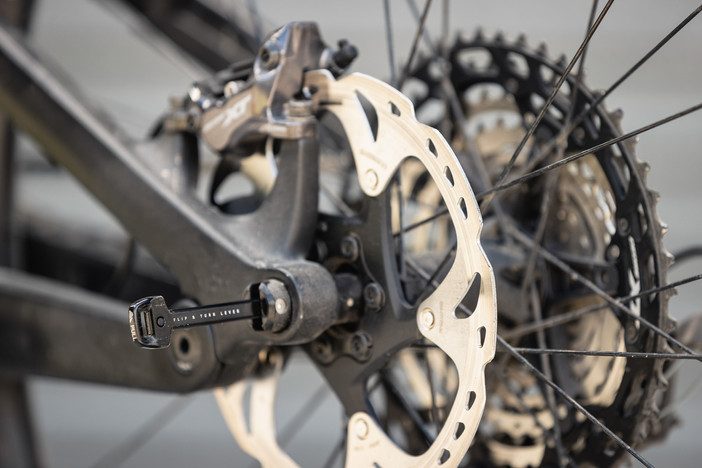
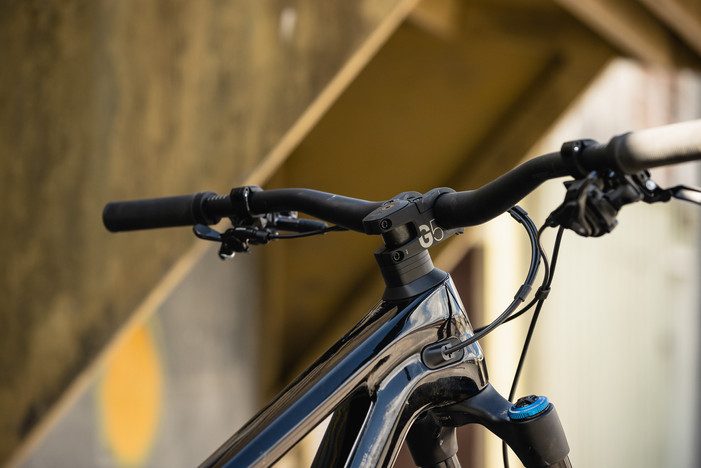
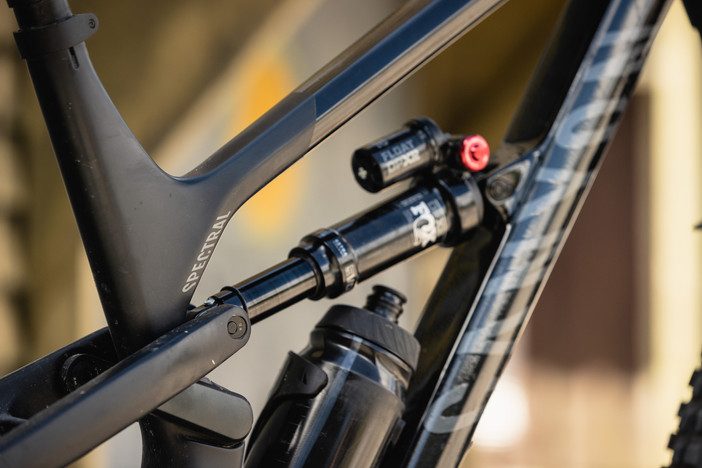
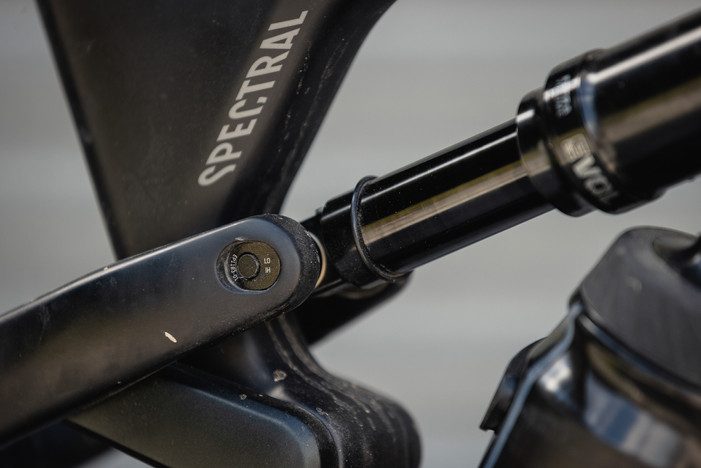
Back to the trails! It’s on the second day when Gaz wanted to showcase one of his iconic loops throughout the lush forest. This is where having local intel or someone that’s been to the area often helps. I always get a little excited about a ride like this as it’s a showcase of the local’s best stuff. You know they’ve ridden the trails thousands of times so you know what they’ll send you down will be the goods. Before we set off for the day, we headed for breakfast at Zippy Central Café. A plate of eggs and a strong black coffee had me sussed for the ride ahead. I’ll let Gaz fill in the details of the trails we did and how he stitched them all together.
“Taking a visitor for a lap of the forest is one of my favourite things to do. Somehow it refreshes my view of a place I have been riding since before there were trails. I know Liam is similar to me in that he likes a decent ride. Even on my own, I am inclined to make most rides a loop - just feels more like I have been somewhere, rather than lapping out a hill.
On this day we went up towards the top of the Tokorangi hill, via the new Forest Loop climb, but before we got where we were headed, we had a mechanical. This wasn’t with our Canyon’s it was with our photographer, Cameron Mackenzie’s bike. We returned to the start via the spectacularly rejuvenated Challenge Middle and dropped in on Ed and Lenore at Planet Bike - not only great coffee in a mid-forest location, but Ed is also a great mechanic. Sorted.
We then headed up through the remains of Chinese Menu, climbed Direct Road and Frontal Lobotomy, and then the top of Tawa Road to get to the native forest which is the roof of Whakarewarewa. My place for mental repairs and the natural trail is Tuhoto Ariki, so we did that.
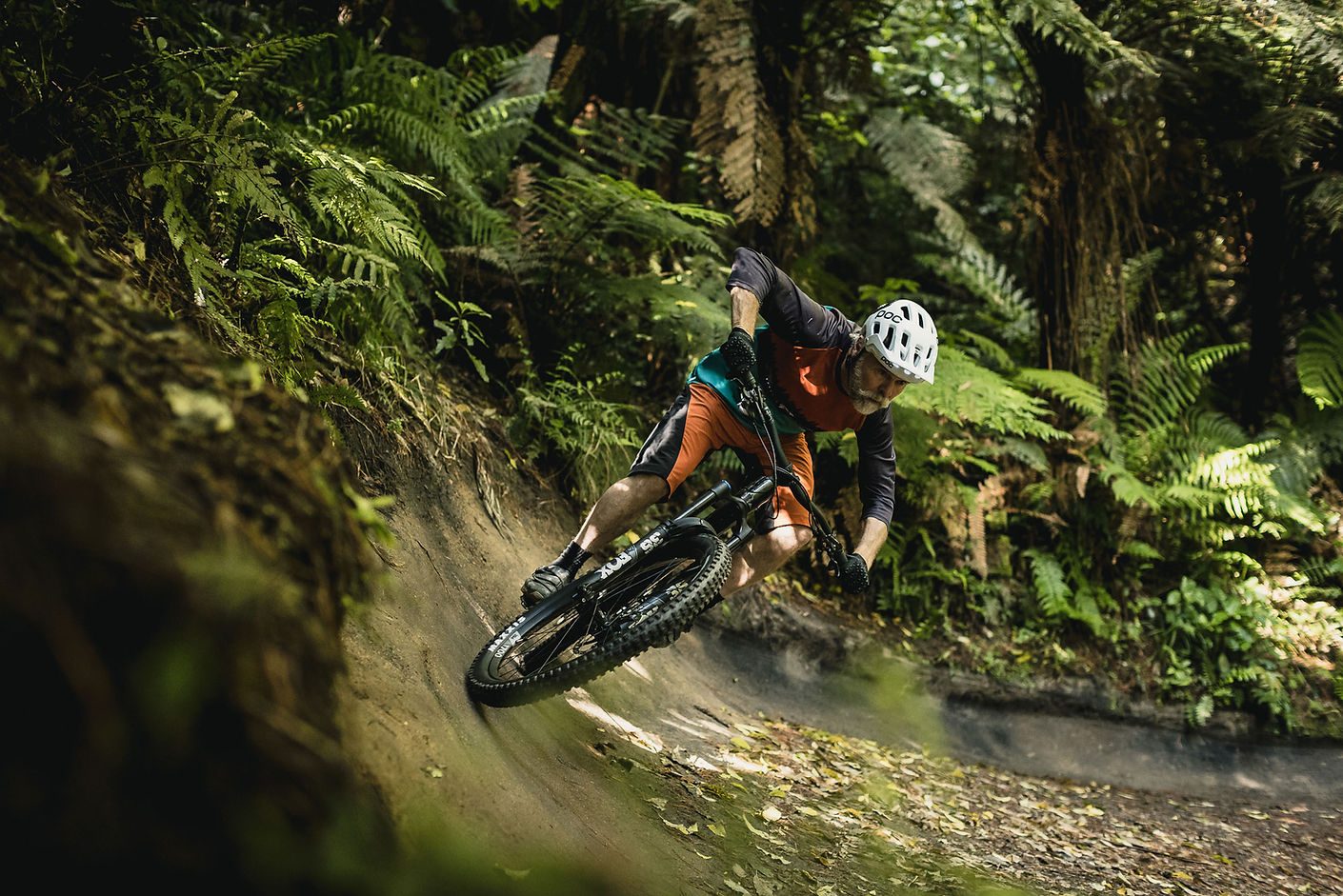
After Tuhoto we turned left and climbed to Te Ahi Manawa. Another natural line, hand scratched out of the dirt and not so manicured as some others, Te Ahi dropped us on to Tikitapu Road.
We took a left again and rolled along there to Tangaroamihi, which is Grade 2 but fun. The main reason for that was so we could inhale some carrot Cake and coffee from the Airstream Cafe at Blue Lake reserve.
We then rode Feeder up to the new carpark at Te Putake o Tawa, to my amazement there was a little coffee and snacks wagon there! Note to self: give them a go.
The excellent Grade 2 Te Pou Koropu Loop trail got us to Apumoana, then we descended Hot Cross and Dragons Tail back to civilisation.”
The day was set out to be epic and it bloody delivered. What’s more, is the bike’s capability to traverse and encounter all of these trails with finesse. The pedal ability of the Spectral 29 was evident as Gaz took me on several uphill trails and fire roads. Whilst pedalling, it’s super-efficient and marches willingly forward with the rear end remaining supportive even on steep climbs. In fact, the rear shock was hardly switched, left wide open it tackled the exposed roots on the ups superbly.
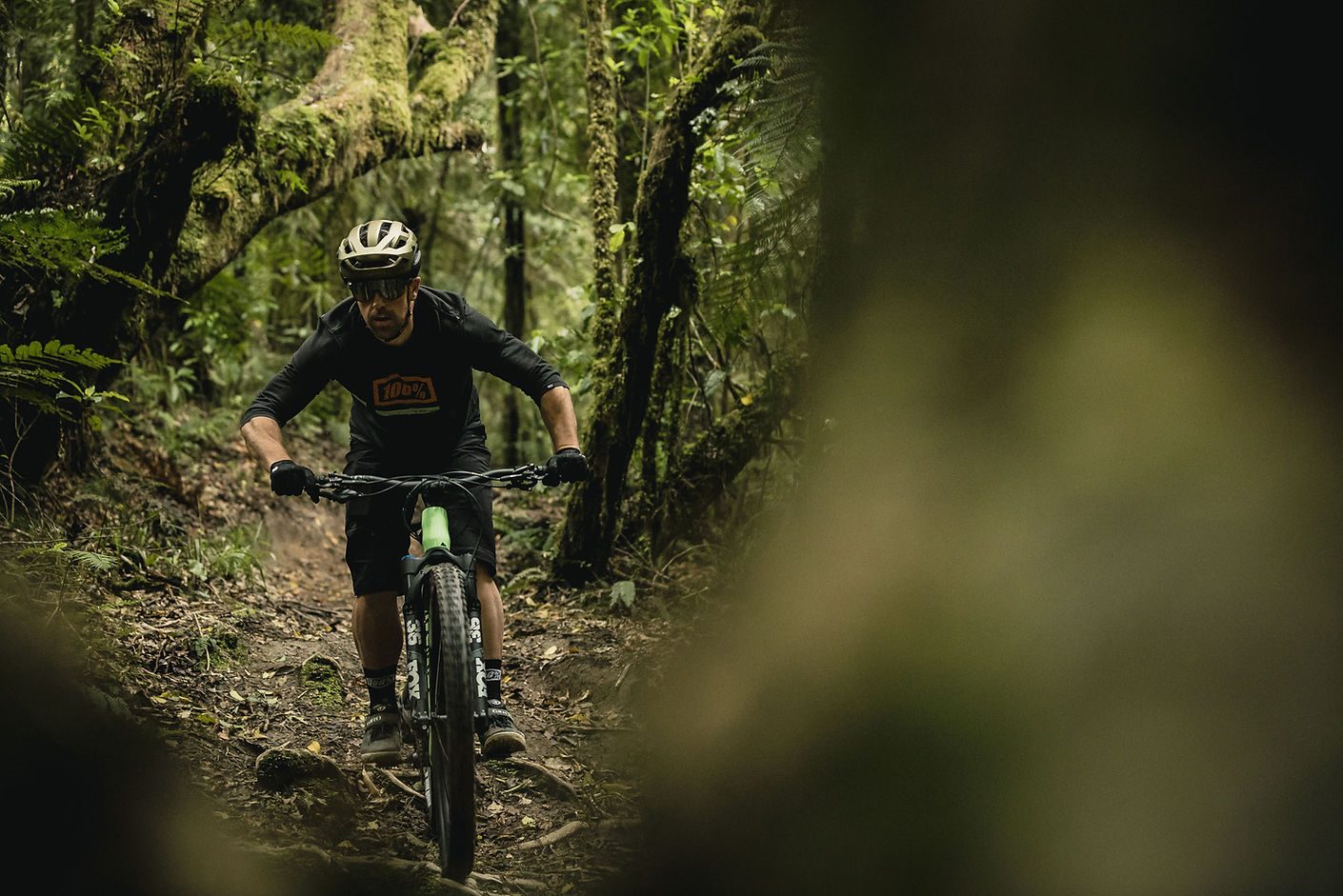
That finesse I mentioned earlier is something that the bike’s given me. Tuhoto Ariki is up there for my riding ability but the bike made me feel comfortable and confident. So much so I could get across, down and around nearly all of the features on the trail. That’s something that I haven’t managed before. As the ride went on my confidence kept growing – down to the bike’s impeccable ability to handle what was handed to it.
The Spectral 29 feels planted, it’s roomy and perches you centrally. The high front end combined with the low bottom bracket integrates the rider well, creating a sense of security. Hence my ability to ride some of the steep terrains. It never made me feel overwhelmed. As we ducked and weaved in and out of the native ferns, shaded in points but the dappled light made it hard to see some the trails. Both of us hadn’t ridden the bike much beforehand but as the day’s ride ticked past three hours, we were both comfortable – that’s impressive. Gaz kept unlocking Whakarewarewa trail gems and I grew fonder of the Spectral 29.
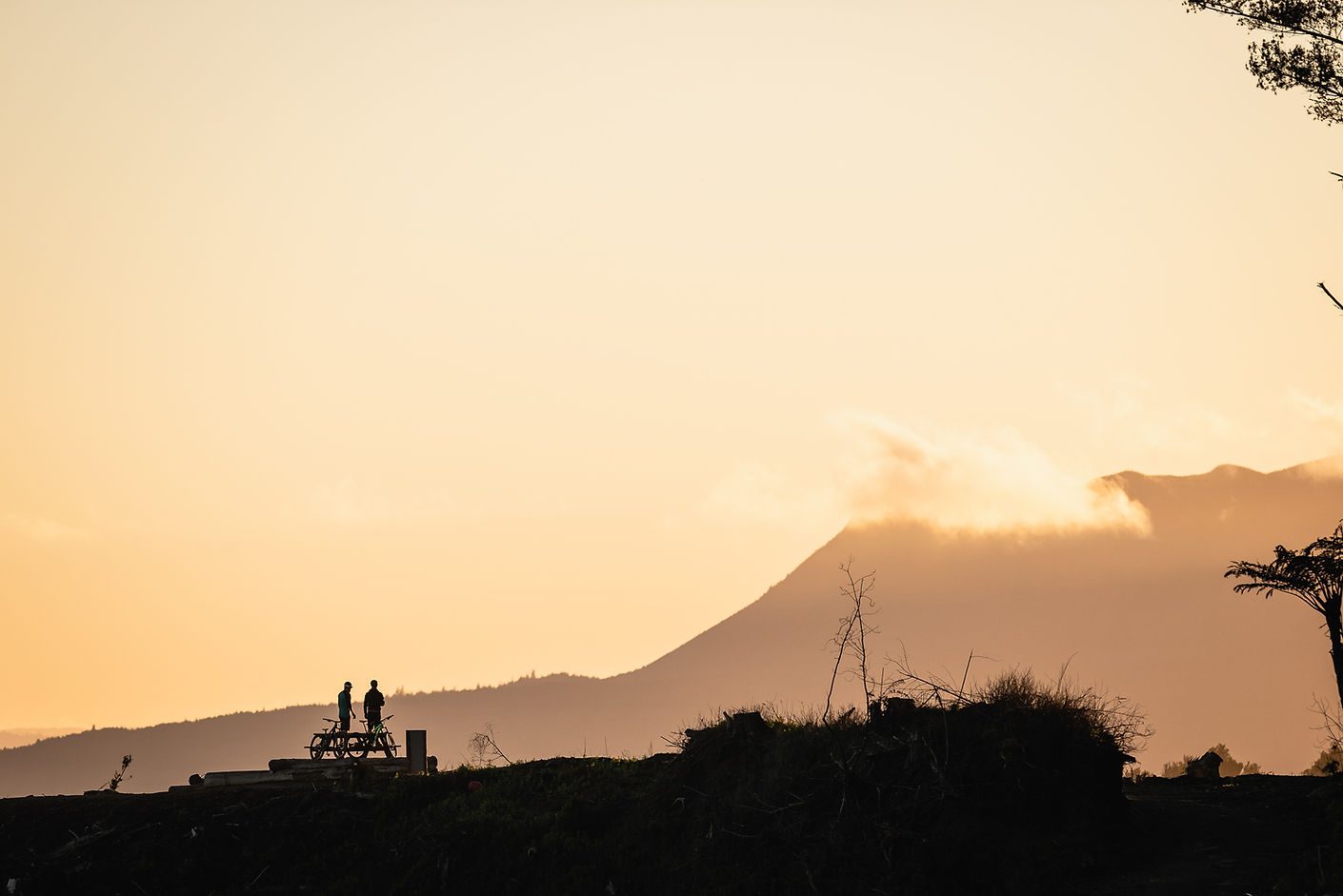
As we pedalled our way back, we both started to feel somewhat toasty from the day’s effort. The Spectral 29 changed direction quickly, accurately and precisely and without much effort. The suspension is sensitive without being too soft. The bike generates a ton of grip but also feedback and lets you know what’s happening on the trail beneath you. The Spectral 29 is damn fun and we were both grinning ear to ear throughout the ride. On completion, we were both toast but stoked from the day’s antics. The bikes performed really well, we had a ton of fun on them and it finished with a beer in the back of Gaz’s van. What more could you ask for?!
As the pink dusk sky shrouded Whakarewarewa we headed to the Secret Spot, which is in Waipa carpark. The Rotorua Mountain Bike Club was holding a gathering. Gaz, the local in this equation knew almost everyone there. I got to see how it was to be a local within this community of enthusiastic bike riders. It’s a real bike town and you can see the absolute passion for the sport when you’re in their company. Before the day was done, we ventured to a local Mexican joint, El Mexicano Zapata. The place was authentic and the tacos were tasty. We washed them down with Mexican beer before chowing down some churros for dessert.
We both came away bloody impressed with how the Spectral 29 performs. It ticks all the boxes for a do-it-all bike – offering a ton of fun across any kind of trail. It’s versatile and capable across a wide variety of terrain, bike parks to flow trails. It’s the one bike you’ll own that really does do it all. I for one was a little unhappy about boxing it back up and returning it.
I reflected on the last 48hrs on my journey back to the big smoke. Rotorua’s a town has ample trails blended with culture and great folk that are truly passionate about their region. It’s remarkable what they’ve built there. But I suppose that’s a reflection on the sport as well as the development of trails. It feels like a real bike town and it’s great to be immersed in that culture. I felt this is what I missed most when returning home. Having the opportunity to see the region through a local’s perspective is a real treat. And, although it’s not always possible I’d recommend connecting with a local in any region you visit. They simply just give you great insights and access to their wealth of knowledge. It’s just like having the keys to the city, or rather trails.
Head to Canyon for more
Words: Liam Friary
Images: Cameron Mackenzie
Story: Ride Welly - Part One
Powered by 100%
Compared to most other mountain bike centres in NZ, Wellington’s biggest advantage is variety. With a great mix of man-made and natural terrain available, rides can be tailored to different levels of skills, or just to mix it up and keep things fresh for even the most experienced riders. The term 'something for everyone is certainly apt when it comes to riding in the capital.
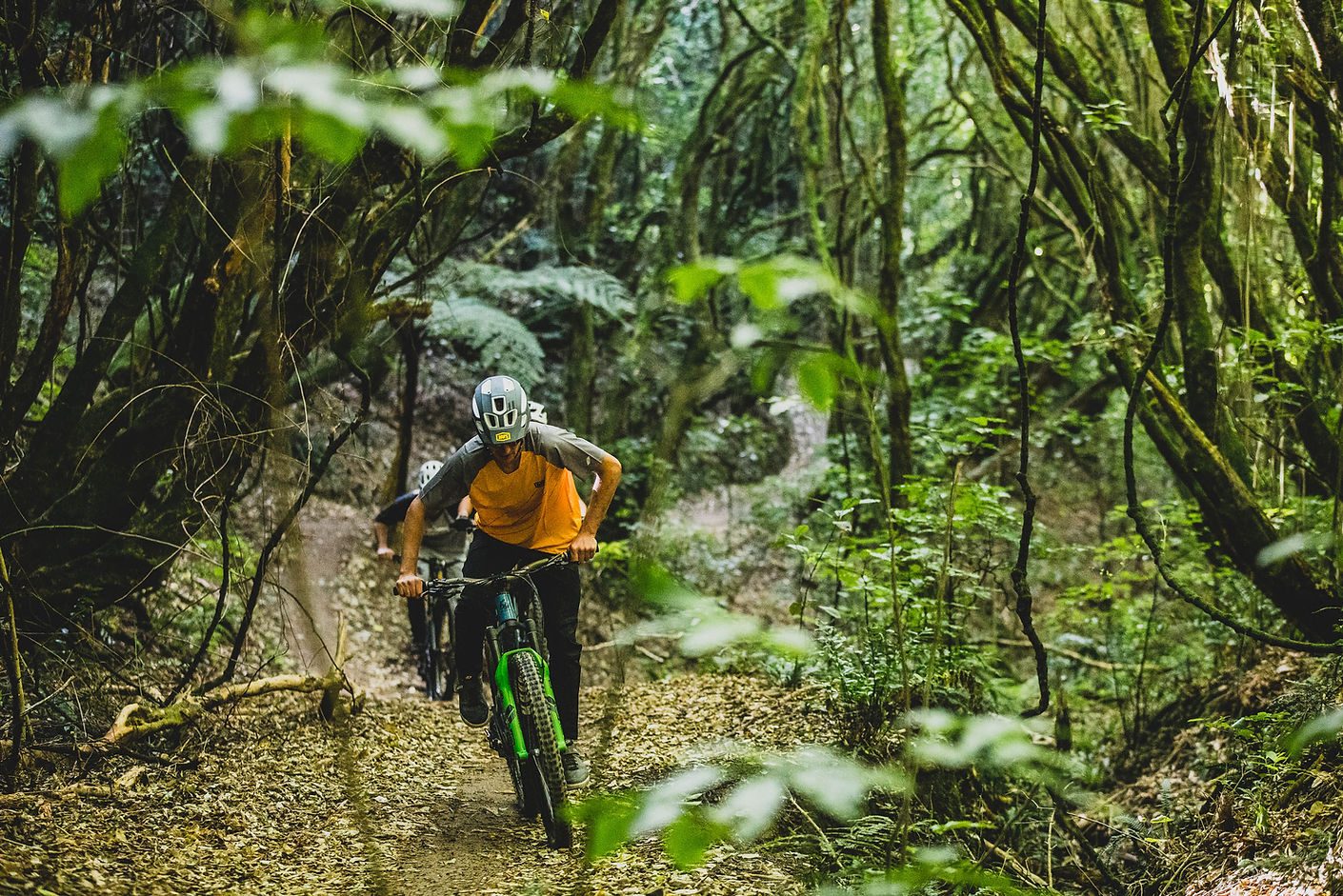
On any given day of the week, you are certain to find a willing riding partner without really looking. You will probably run into other riders out for a quick spin, or maybe an all-day mission. I’ve met some of my best friends and riding buddies just by being on the trail at the right time and striking up a conversation. With such a large and friendly rider base, the local scene is fantastic for finding just the right people to ride with and to socialise with when the riding is done.
But it’s the quality of riding that led me, and many others, to choose Wellington as the place to be for a mad-keen mountain biker. I love being able to leave my house and be on dirt within five to ten minutes depending on which direction I point my bike. I can link up two or three different riding areas or bike parks without my tyres hitting the tarmac. And those same tyres will have touched an array of trails from smooth and groomed, flowy, fast, to technical, rocky, steep and challenging. My mood dictates how I want to ride, and the trails do the rest. Hard to beat is an understatement.
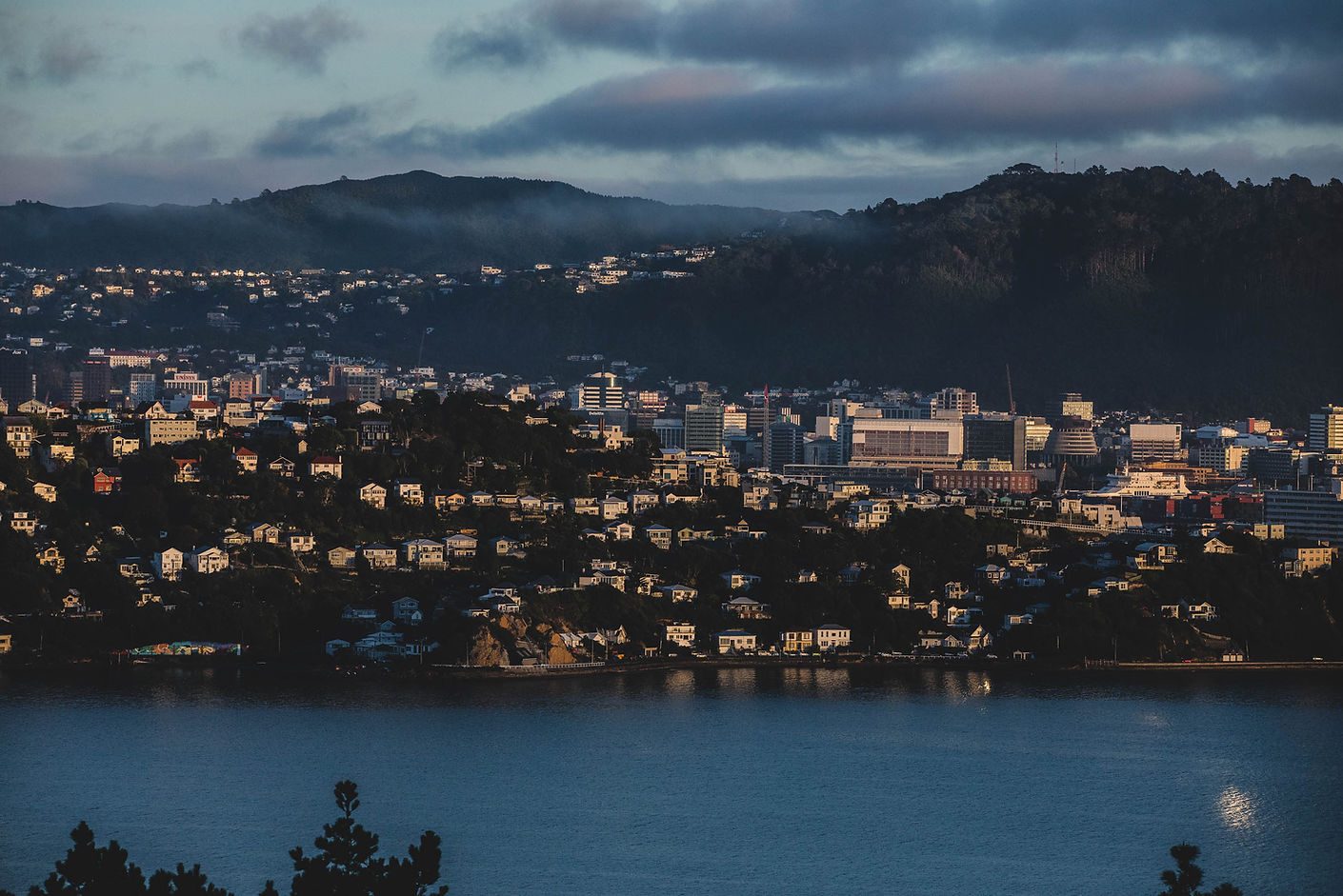
Polhill
Probably the most popular trails in the city these days, the easy accessibility of Polhill Reserve makes it a must ride for the visitor. From the CBD you can be on the singletrack within minutes. The Transient climb is another one of those Wellington climbs where you don’t really feel like you’re climbing at all, and before you know it you are at the top of Brooklyn Hill, home to Wellington’s original wind turbine and gateway to a number of options. You can head back down the way you came via Car Parts, a twisty blast through the trees, followed by a choice between the latest additions Roller Coaster for a bit of airtime, or a fast and twisty run down Ikagai and Serendipity, or continue on towards the south coast via Barking Emu. The views along here are just as epic as Makara, but with some different perspectives. I never get sick of looking out over this beautiful city with its rugged hills and bays, harbour and coastline. From the end of Emu, either turn around for a long descent all the way back to where you started or head down to Red Rocks, via high-speed doubletrack with some nice twisty singletrack at the end, spitting you out on the coast for a ride back to civilisation via the road or a pre-arranged lift.
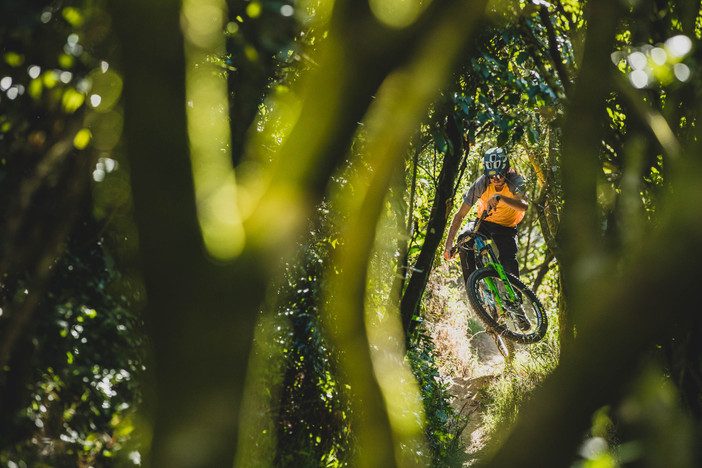
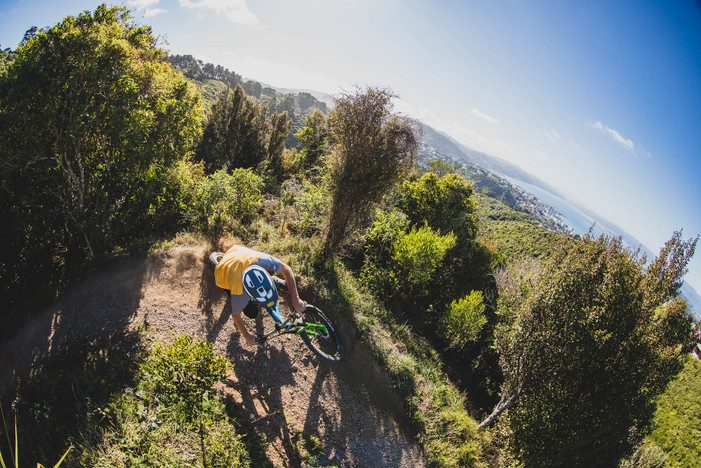
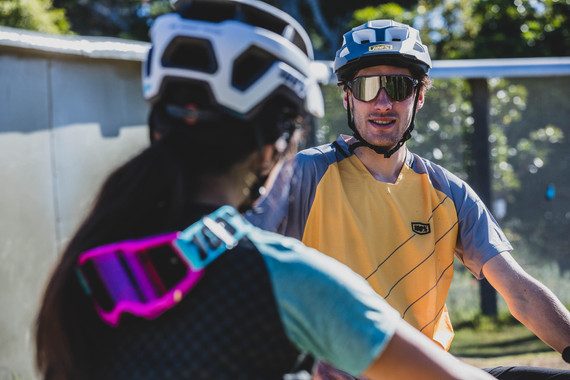
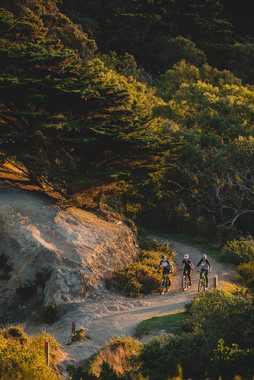
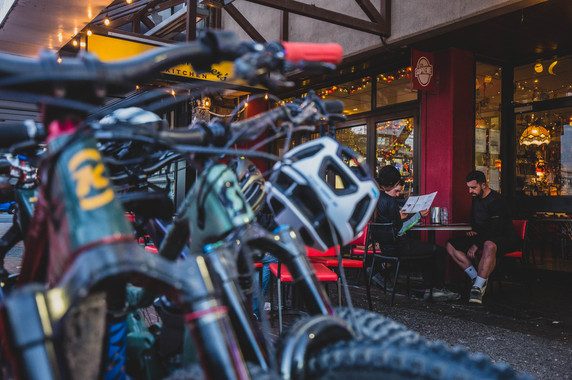
When The Riding Is Done (Or “Aprés Singletrack”)
There are so many great places to ride in NZ that it’s hard to choose the ideal location to base oneself to live a mountain bike lifestyle. Known as one of, if not the arts capital of NZ, Wellington has a plethora of theatres, cinemas, bars, cafés and of course the National Museum, Te Papa. There is a vibrant bar and live music scene, with craft beer not only being served in abundance but brewed right in the city by some of the country’s best and most decorated brewers. And we know that mountain bikers love a good brew after a day of amazing riding, so why skimp on the quality of the beer?
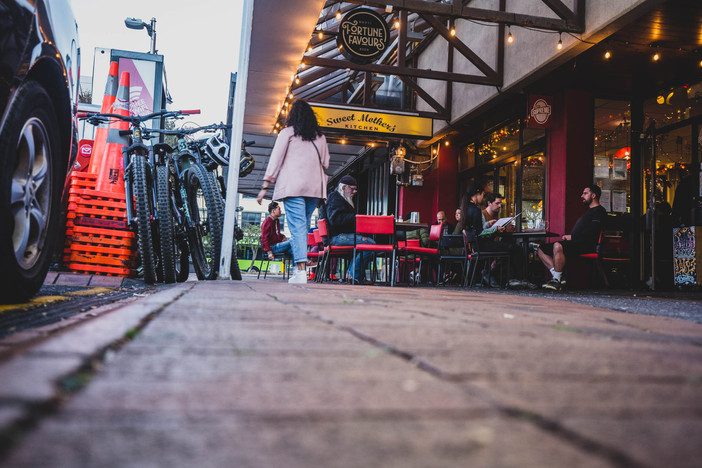
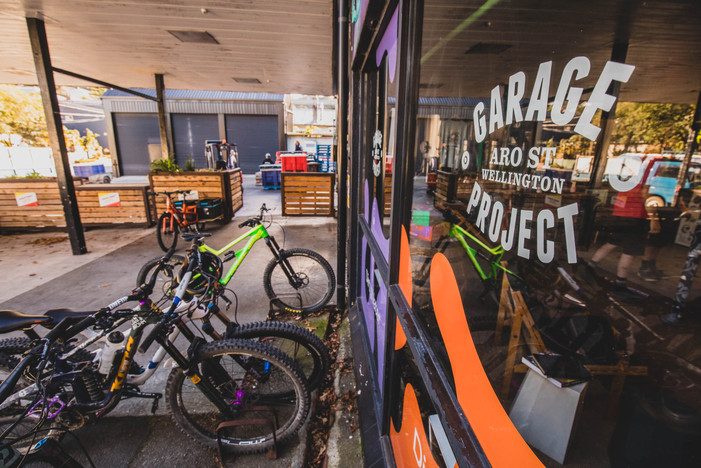
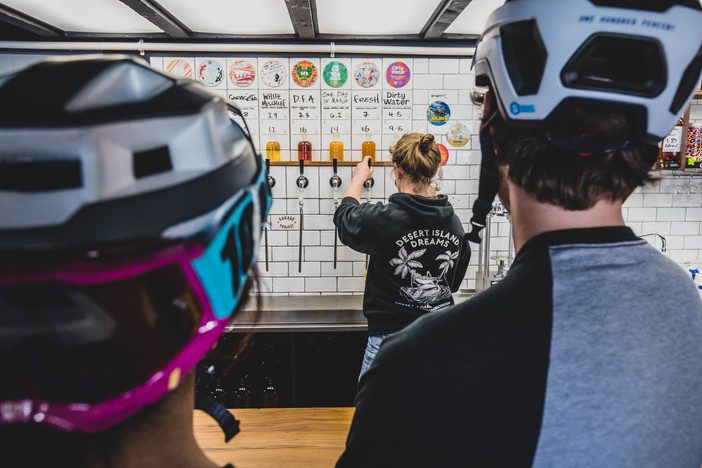
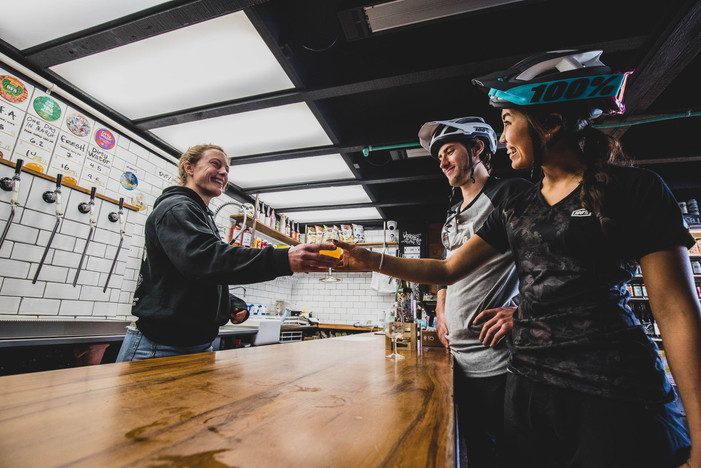
There are countless international renowned restaurants and so many choices of fantastic eateries that I’m still working my way through them all! And if you like coffee, well you’re in heaven here; Wellington has more cafés per capita than New York City. And yes, the coffee is also recognised as the best in the country and also world-beating.
Stay tuned for the second part of this story, dropping on the 20th of May
Words: Brett Kennedy
Images: Caleb Smith
Review: Granite Design's RocknRoll Tool Roll
Granite Design have been making a bit of noise over the past year or so. I first met Dominic Loh, brand manager for Granite, at Crankworx 2019, where he showed me what was a relatively small product line and told me what they had in the pipeline. Since then, those products have come to fruition and local supplier, Everoutdoor, sent some our way to test.
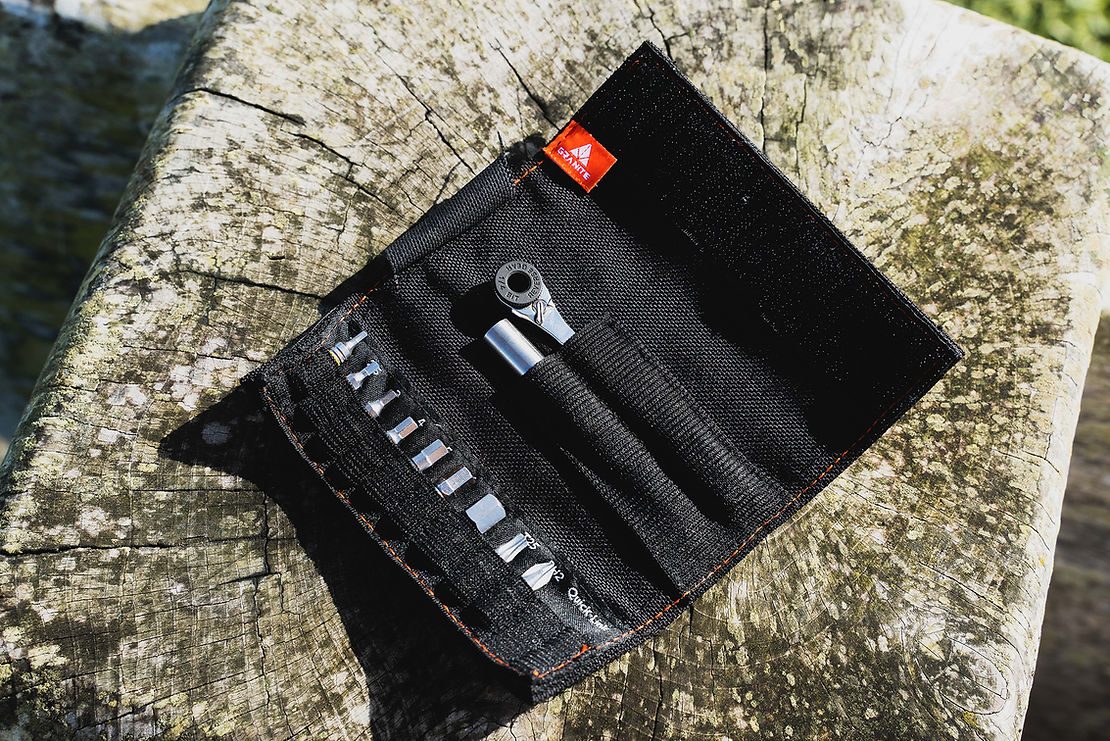
It seems like the mountain biking industry is on a never-ending quest to give you as many different ride tools as possible to choose from. Mini ratchets have become one of my favourites. The slim rolls they come in are nicer to carry in your pocket if you’re riding without a pack, and the ratchet is just a ton easier to use than a traditional multi-tool. The Granite Design RocknRoll is their take on the mini ratchet, and it’s accompanied me on most of my rides for the past six months or so.
The RocknRoll kit comes in a Cordura tool roll, that includes a loop on the back to route the Granite Design RockBand (or most other tool straps) through, so you can mount it to your frame. With nine bits and an extension included, the RocknRoll has everything you’d need to tackle any trailside repairs, and the extensions make life much easier when it comes to accessing some of the harder to reach bolts. The ratchet is comfy in hand, and all the bits so far have stood up to the trailside tweaks I’ve made, and building/disassembling bikes whilst travelling.
The RocknRoll has pretty much done exactly as it should really and I don’t have any complaints, although, as time has gone on the ratchet gear has begun slipping occasionally, mostly on tighter bolts like my rotor bolts and brake mounts. It’s tricky, seeing as these are bolts you don’t usually mess around with on the trails, but at the same time when you’re travelling regularly, you’re forced into using what you’ve got and what’s convenient. The Granite Design site also reckons the RocknRoll can handle up to 60Nm of torque at the gear, so it was a little disappointing to find it slipping on bolts when I wasn’t even close to 60Nm.
All in all, would I suggest the RocknRoll? I’d say so. It’s small, convenient and reasonably priced with a recommended retail price of $59.99. Whilst the gear slips occasionally now, I’ve used the tool a ton over the last six months and I’d happily replace it with a new one, given that if I wasn’t using it as often as I have been I’d expect it to last a lot longer. I think that’s another thing about the lower RRP – I’d way rather lose a $59.99 dollar tool and replace it, over paying for something more expensive and potentially a little more durable, only to lose it on the side of the trail or travelling.
Words & Image: Cam Baker
Arrival: earSHOTS
I was pretty stoked when the postie arrived with these! earSHOTS are a Kiwi company making headphones for use in outdoor sports, specifically mountain biking. After five years of development, they're now available for purchase from their online store.
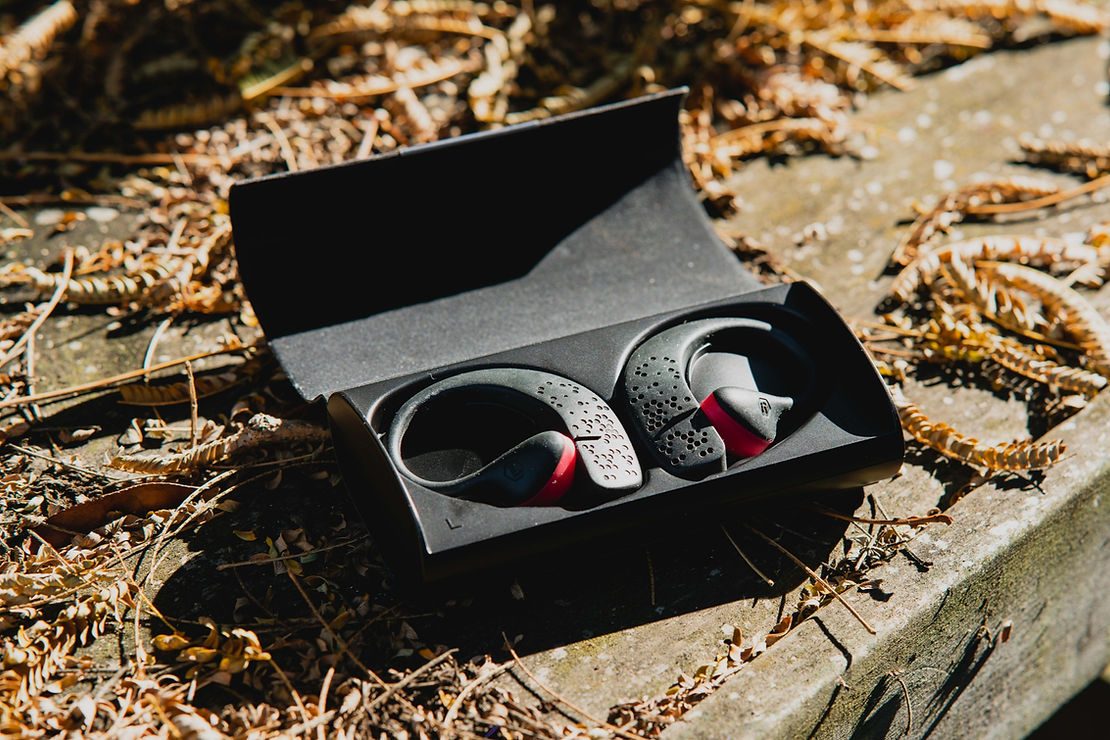
The earSHOTS are a wireless bluetooth headphone and come with an included charging case. As you'd expect, they're waterproof, and they also feature a magnetic clip that's designed to help them stay on your ears. I don't have a ton to say on them yet, other than the fact that they feel well built, are comfy and sound great, but you can be sure I'll put them through their paces and have a full review soon!
Words and Image: Cam Baker
News: Wahoo & Zwift Shred Sessions
With many trails closed, and athletes choosing to ride indoors in order to more easily maintain social distance, Wahoo has decided to help mountain bikers connect with some of the sport’s biggest stars through the Wahoo Shred Sessions series.
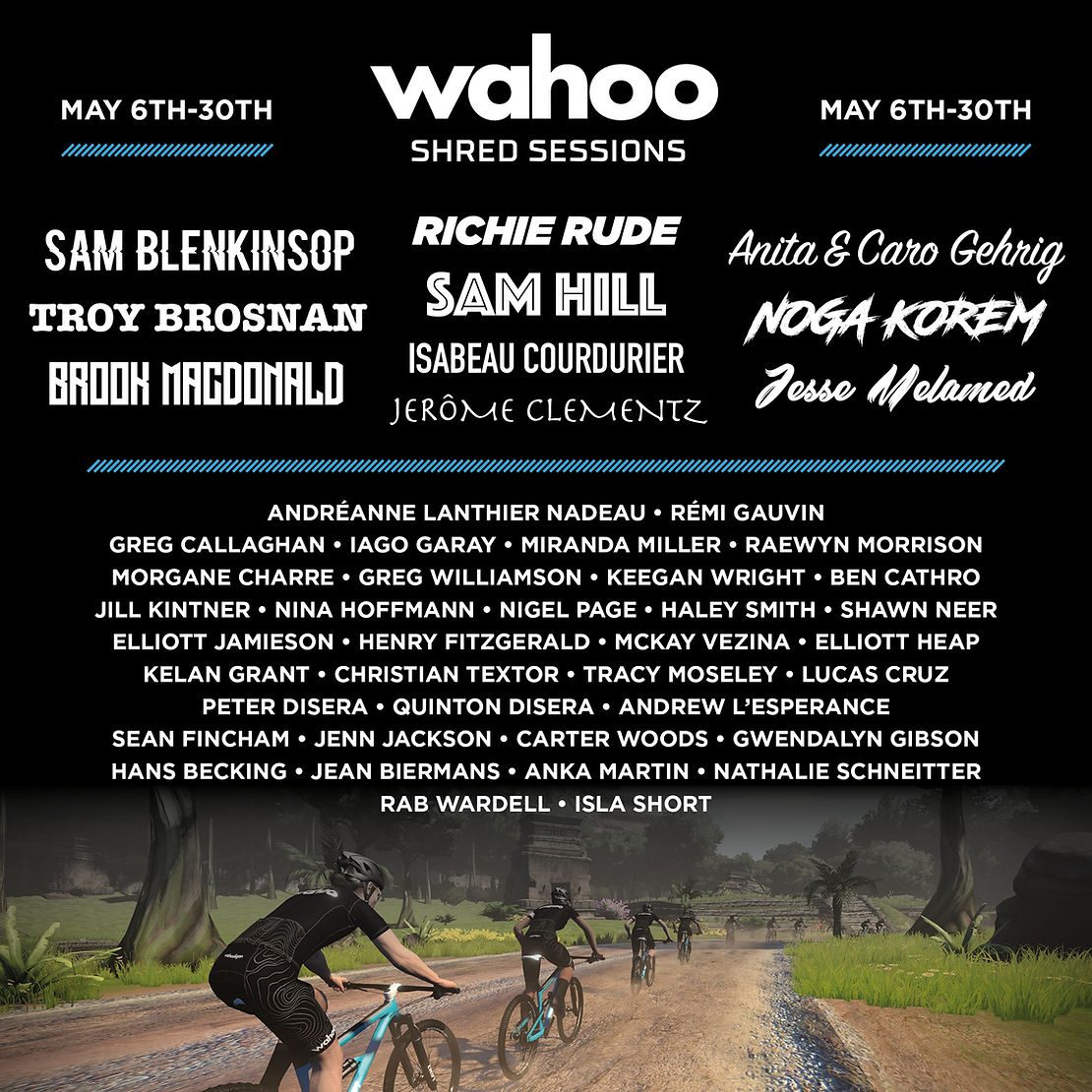
The Wahoo Shred Sessions will kick off on May 6th and will continue every Wednesday and Saturday (Time zone dependent) in May, with three times offered throughout each day to ensure that athletes in most time zones will be able to join. Each ride will feature a different Pro MTB rider serving as a ride leader, who will be available to chat with ride participants and ensure that the ride stays at a civil, inclusive pace where cyclists can ride together and commiserate about the challenges facing our community during this unprecedented global health crisis.
“With trails closed in many places, or too crowded to allow safe riding, we wanted to give mountain bike athletes the chance to ride together and socialize in a safe environment,” said Colin Eustace, Vice President of Global Marketing for Wahoo. “For many mountain bikers, this is a special opportunity to ride with some of the sport’s biggest stars -- the kind of interaction that would be singular and memorable, with or without a global pandemic.”
EWS Rider Caro Gehrig said; "When I approached our sponsor Wahoo to organize a single ride for the Enduro World Series riders I never thought a few weeks later we would end up at this and find ourselves with a list of the most decorated riders in the world keen to take part in a whole series! With no racing happening it is an amazing opportunity for the athletes and fans alike to ride together. It's a cool way to stay connected and fit at the same time through these troubled times, I can't thank Wahoo & Zwift enough for providing this virtual meeting ground. I can’t wait to meet some other riders and MTB fans!"
While the weekly rides are intended to be casual and social, the month will conclude with an MTB ‘Royal Rumble’ to give everyone the chance to race each other, just for fun.
Rides leaders will include Troy Brosnan, Brook Macdonald, Noga Korem, Sam Hill, Anita and Caro Gehrig and over 50 other Pro’s across Downhill, Cross-Country and Enduro.
There will be a total of 24 rides over the course of four weeks covering all time zones twice weekly. Complete information on the rides, including a separate list of times in other times zones and instructions for signing up, can be found here.
Other virtual events hosted by Wahoo athletes include Pete’s gravel ride with Pete Stetina, Frodissimo Fridays with Jan Frodeno, and Team Charles-Barclay Track Club with Lucy Charles-Barclay. Complete information on all Wahoo virtual events is available here.
Tech Tips: Contact Points
Preface: I wrote this last summer, but given that most of us have more time now than ever, I thought it'd be a good time to share it again with you all
I ride more in the summer than I do any other time of the year and because I usually have a bit of time off, I like to spend my riding time trying out different things on my bike to get it set up for the year ahead while I’ve got the time to stack up consecutive ride days. With that said, there’s no better time than now to talk you over some of the components on your bike that you can experiment with, and how they’ll change your riding experience.
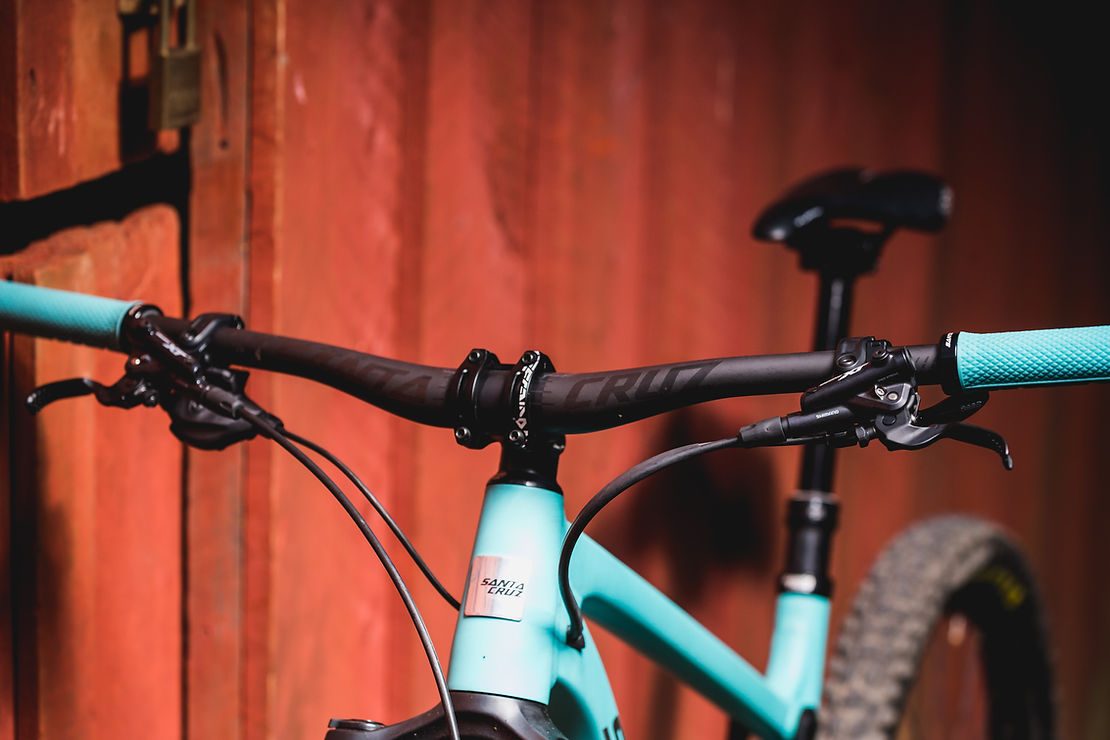
STEM
Your stem is a fairly vital component to your bike. It’s responsible not only for transferring your bike handling inputs from the handlebars to your front wheel, but also for transferring feedback from your wheel to your handlebars. Stems come in varying lengths, each having a different effect on your ride. If you feel like your steering is a little twitchy and that your front wheel picks up a little easy when you're climbing, try a longer stem – this will slow down your steering and shift your weight forwards a little. If you feel like your steering is a little slow and sluggish, try a shorter stem. For reference, I typically settle on a 40-50mm stem dependant on the bike. You can also raise or lower your stem if you've got extra space on your steerer tube, but we'll save that for another article...
HANDLEBARS
Handlebars are a somewhat controversial topic. Carbon or aluminium? Wide or narrow? Changing handlebar width is something that immediately impacts your ride. The wider you go, the more stable you are, but the slower your steering. The narrower you go, the less stable you are but the faster your steering. Something to bear in mind though, is the wider you go the harder it is to squeeze between trees. For reference, I’m 6’1 and fairly broad across the shoulders and ride 780mm bars. If you’ve never tried narrower bars, you can try sliding your grips and levers in 5-10mm per side - just make sure to plug your bar ends with bar caps or plugs to avoid kebabbing yourself should you come off! This is an easy way to try before you commit to cutting them down! I haven't touched on handlebar rise or tilt, but stay tuned.
GRIPS
Like seats, I’ve found grips typically take a few rides to break in. Grips are easy to change so, while you’ve got time off, why not try something new? I’ve been riding lock-on grips for the last few years so this summer I think I’ll try slip-ons again. I’ll probably make a mess of it and end up gluing myself to something, but the comfort that comes with the extra-thick slip-on grips is pretty appealing. I’ll update you sometime in the future with how I fared…
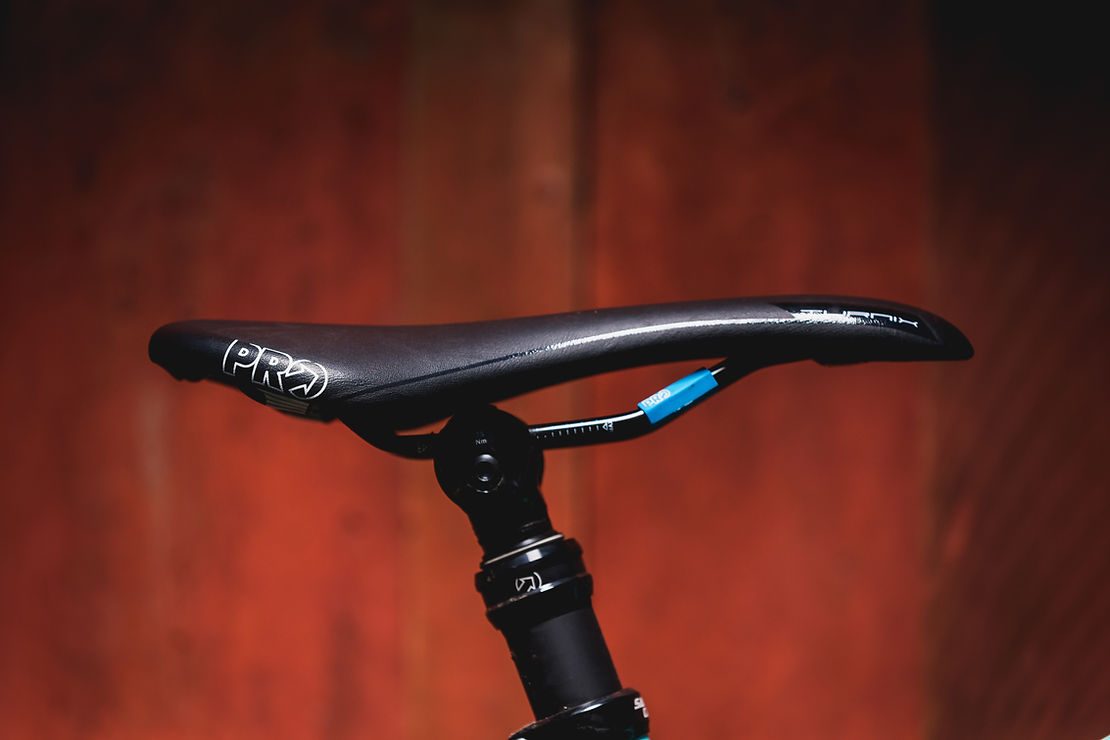
SADDLE
Saddles are one of those things that can make or break a ride for you. I can usually tolerate average shifting or brakes that are subpar, but give me a seat that I don’t gel with and you won’t hear the end of it. The tricky thing with seats, is that they usually need to break in before you can really tell what they’re like. I’ve had seats that I loved on Day One and hated after a few weeks, and seats that I hated on Day One but have come to love once they were broken in. While you’ve got plenty of time to ride, try a new seat if you’re not stoking on your current seat. Comfy seat = quality ride.
PEDALS
Clips or flats? Everyone has their own preference. Mine is flats, at the moment. The main reason? The shoes are comfier, I've been crashing lots and I'm liking the bigger platform. You’ve got some time to kill so why not swap systems for a few weeks? The whole foot-out-flat-out thing is pretty fun in the summer’s dust and if you normally ride flats, no matter how good your technique is, it’s way easier to dance your rear wheel around accurately with clips.
If you haven’t already noticed, all of the above are contact points. Contact points are our source of feedback. We use that feedback to make decisions on the trail; when to brake, how hard to break, how much faster you can ride that section of trail. We also use that feedback to make decisions on what components to upgrade and what settings we need to change. Unlike the pros, we don’t have suspension telemetry and GPS data to tell us what’s working for us and what isn’t so, I think before anything else, we need to have our contact points dialled. Even if you aren’t interested in going as fast as possible, dialled contact points means a comfier ride - and who doesn’t want that?!
Words: Cam Baker
Images: Cameron Mackenzie


